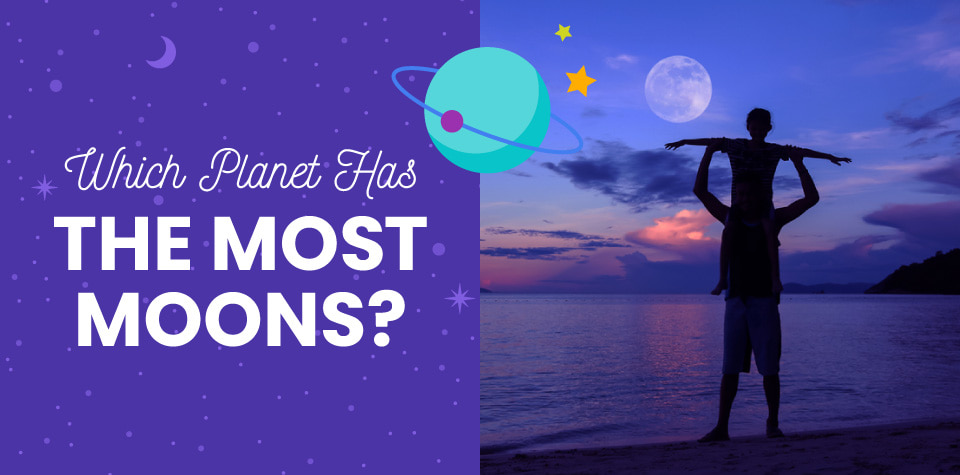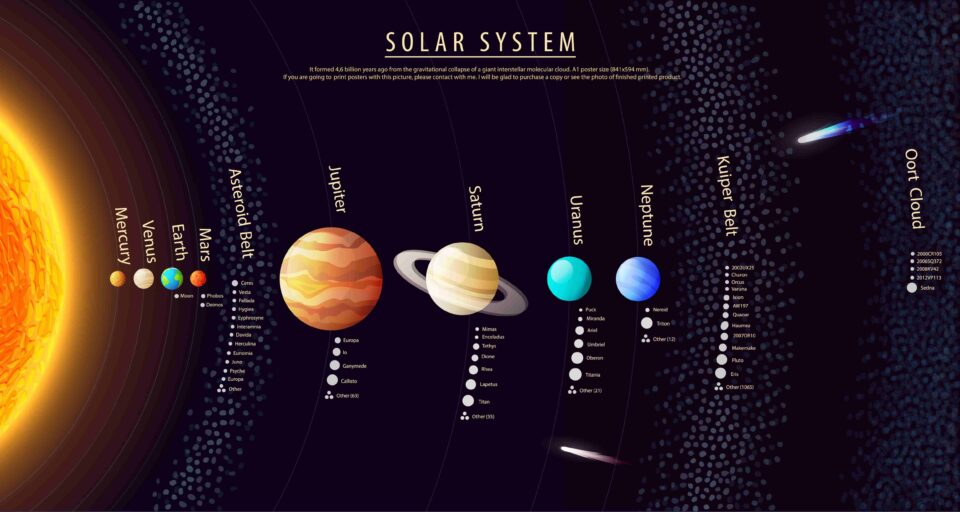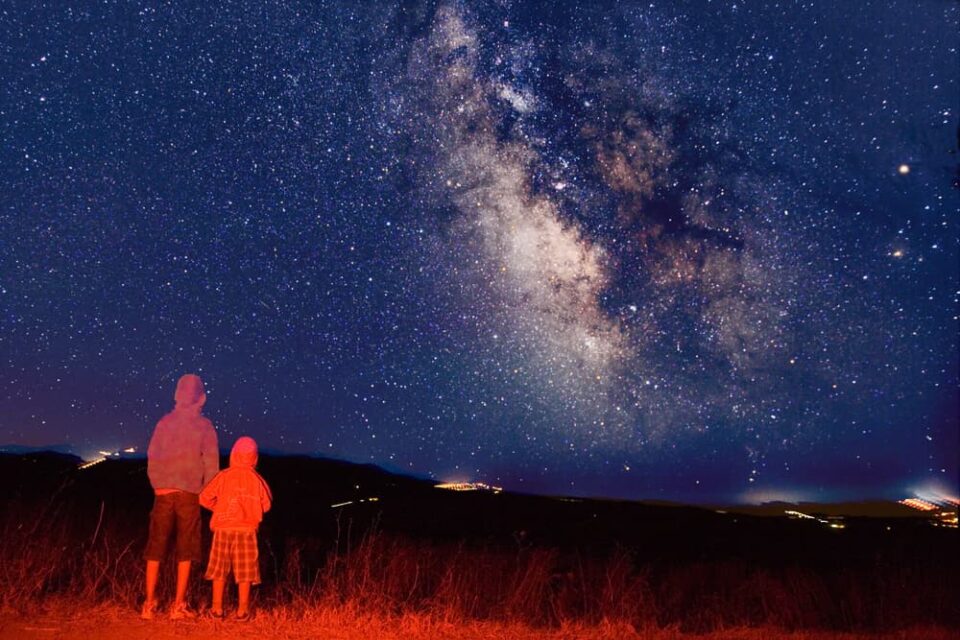
Discover Which Planet Has the Most Moons
Most of us know it as the Moon, but Earth’s nighttime companion has many names: Luna, Selene, Máni, Chang Xi —the list goes on and on. It has influenced our culture, art, history, and even medicine. If your space explorer is asking questions about our nearest celestial neighbor, just imagine how keen they’ll be to learn more about outer space when they discover the eight planets in our solar system collectively have hundreds of moons!
Some of those moons host huge volcanoes, seas of methane, mountains of ice, and maybe even alien life! Prepare to blast off on your journey of cosmic discoveries by unearthing which planet has the most moons and other fascinating lunar facts.
What Exactly Are Moons?
Moons are natural satellites that orbit planets, and just like planets, they come in all shapes and sizes. They’re usually solid and may or may not have an atmosphere. Scientists believe the moons in the solar system first began to form from gas, dust, and other debris that circulated around the planets in the early days of the solar system billions of years ago. The massive gravitational fields of some planets called gas giants, like Jupiter and Saturn, can pull other satellites into their orbits, which is exactly what happened to many of those planets’ multiple moons.
Of the eight worlds in the solar system, only two planets have no moons—Mercury and Venus. And it’s not just full-sized planets that have moons. The dwarf planet Pluto has several moons, and astronomers have also discovered very small moons orbiting asteroids as they travel through space.

How Many Moons Does Each Planet Have?
Ready to see which planet has the most moons? Let’s do the numbers:
Earth
- Number of moons: 1
- Moon, also known as: Lune (French), Quamar (Arabic), Måne (Danish), Chandra (Hindi)
- Fun fact: Because the moon lacks an atmosphere, there is nothing to protect it from meteors and asteroids. That’s why it has so many craters marking its surface! The South Pole-Aitken basin is one of the largest craters in the solar system, stretching across 1,550 miles (2,494.5 km). That’s fifteen times wider than the biggest crater on Earth, the Vredefort Crater in South Africa.
Mars
- Number of moons: 2
- Mars’s biggest moon: Deimos
- Fun fact: Phobos, the smallest of Mars’s moons, orbits the planet only 3,700 miles above its surface and completes three orbital revolutions daily. It’s moving closer to Mars by .7 inches (1.8 centimeters) every century and will eventually crash into its surface within the next fifty million years.
Pluto
- Number of moons: 5
- Pluto’s biggest moon: Charon (half the size of Pluto itself!)
- Fun fact: This dwarf planet and its largest moon have a unique relationship. Instead of circling Pluto, Charon faces it, and the two spin together around a fixed point in space. They act more like a binary planetary system.
Neptune
- Number of moons: 14
- Neptune’s biggest moons: Triton, Proteus, Nereid, Larissa, Galatea
- Fun fact: Triton, Neptune’s largest moon, is unique in the solar system. The other moons orbit in the same direction as Neptune’s rotation, but Triton travels in the opposite direction, which scientists call retrograde motion. They believe that happens because Triton didn’t form in Neptune’s orbit. Instead, it floated freely through space until it was captured by the planet’s gravitational field.
Uranus
- Number of moons: 27
- Uranus’s biggest moons: Miranda, Ariel, Umbriel, Titania, and Oberon
- Fun fact: The solar system’s highest cliff, the Verona Rupes, is found on Miranda. It’s estimated to be 12 miles above the surface, and if you were to jump over the edge, it would take 10 minutes to reach the ground. Voyager 2 discovered the cliff during its flyby in 1986.
Jupiter
- Number of moons: 79
- Jupiter’s most distinctive moons: Io, Europa, Ganymede, and Callisto
- Fun fact: Galileo discovered Jupiter’s moon Europa in 1610. Today, scientists believe it is covered by a huge ocean topped with a thin layer of ice.
Saturn
- Number of moons: 82
- Saturn’s biggest moons: Titan, Rhea, Iapetus, Dione, Tethys, Enceladus, and Mimus
- Fun fact: Initially, astronomers believed the ringed planet had 62 moons, coming in second to Jupiter. In 2019, scientists led by Scott Shepard at the Carnegie Institution for Science discovered another 20 natural Saturnian satellites, bringing the total up to 82.
How Do Moons Get Their Names?
Now that you know how many moons each planet has, let’s learn more about how the moons got their names.
The responsibility for naming new moons belongs to the International Astronomical Union. When astronomers first observe a moon, it receives a provisional name, like S/2009 S1, the designation of the first satellite discovered orbiting Saturn in 2009. Once a new moon’s discovery is confirmed, the IAU names it after a mythological character. For example, Saturn’s new moons take their names from Norse mythology, such as Bergelmir, a giant whose name means “one who roars like a bear.”
Of all the known moons, only Uranus’s have names based on characters from literature. Astronomers named the majority after Shakespearean characters, such as Puck from A Midsummer Night’s Dream and Desdemona from King Lear. Two of its moons, Ariel and Umbriel, take their names from the works of another famous English poet, Alexander Pope.

Why We Earthlings Love Our Moon
Earth’s Moon is only 238,855 miles (384,400 kilometers) away, making it our nearest neighbor. Because it’s so close, we’ve been able to study it more extensively than any other celestial body in the solar system. Astronomers have built on that knowledge to learn about natural satellites in regions of space far beyond Earth’s orbit.
Is your future space traveler ready for more out-of-this-world adventures that go beyond the Moon? Team up to craft an astronaut companion to keep you company as you investigate all the wonders of outer space, like where the coldest place in the universe is or why planets are round. Or help your child discover the wonders of the universe and other STEM-based topics by subscribing to our Science Junior subscription box, full of creative, science-based activities and crafts to keep them exploring for days.
